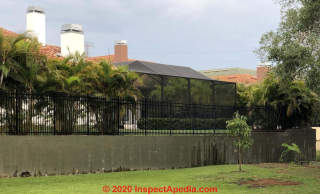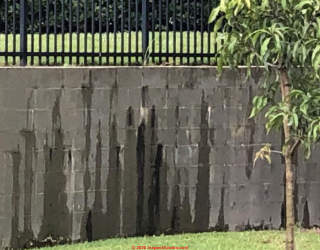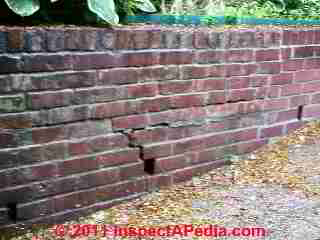 Retaining Wall Water & Frost Damage
Retaining Wall Water & Frost Damage
causes, cures, prevention
- POST a QUESTION or COMMENT about retaining wall types, designs, materials, and retaining wall guard railings & building codes
Retaining wall damag due to water (or wat r+ frost or freezing): identification, troubleshooting, cures.
This article series describes types of privacy walls, retaining walls and retaining wall guard railing requirements, guard railing construction and building codes, and critical safe-construction details for retaining wall guardrails.
InspectAPedia tolerates no conflicts of interest. We have no relationship with advertisers, products, or services discussed at this website.
- Daniel Friedman, Publisher/Editor/Author - See WHO ARE WE?
Frost or Water Damage to Retaining Walls & Privacy Walls
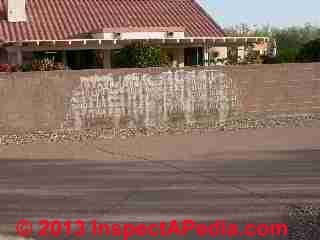 Water damage to retaining walls and privacy walls ranges in import from cosmetic (photo at below left) to catastrophic collapse that can damage other property or even injure or kill someone.
Water damage to retaining walls and privacy walls ranges in import from cosmetic (photo at below left) to catastrophic collapse that can damage other property or even injure or kill someone.
Our photo at left illustrates lime or calcium deposits staining an above-ground privacy wall in Surprise, AZ.
I suspect that a plant sprinkler system on the other side of the wall is soaking the masonry in this area - a theory that is supported by the reader report and photos of a different home described just below.
Watch out: at the beginning of our article on types
of RETAINING WALL DAMAGE we describe catastrophic retaining wall collapses traced to water loading behind the wall.
Water accumulating behind a retaining wall adds significant weight to that of the earth already present
- this force is known as the wall surcharge, explained separately
at RETAINING WALL DEFINITIONS.
Question: is my neighbor's leaky retaining wall dangerous or in need of urgent repair?
I was looking for an opinion on the included picture. This block wall must be around 6 years old
. Its constantly leaking water in the one section pictured and flow increases after rain and gets less during dry spells (we live in western Florida).
The wall is on our neighbors property
In case of failure it poses no hazard to our house as we have a large yard (it extends up to the wall).
Still I was wondering if this is something we should be concerned about and maybe give out neighbor a heads up or if this is nothing to be concerned over.
Any insight would be appreciated. Thank you.
[Click to enlarge any image]
Reply:
 Thanks for the leaky retaining wall photos and question, Benny.
Thanks for the leaky retaining wall photos and question, Benny.
I notice that the wall appears to have been built without weep or drain openings, so water behind the wall finds its way out at random locations and at the very least, is ugly.
In Florida where you're not likely to be worried about frost damage that would occur in such a wall further north, still the weight of wet soil can, over time, press on the wall leading to cracking and ultimately to failure.
Along most of the wall (closeup I'll post below) we see that water is coming out along the wall bottom - where retrofit weep openings could relieve pressure.
However I also notice in an area corresponding to what looks like a Florida room or enclosed porch there is much more water leaking out of the retaining wall beginning near the wall top.
One might ask, why?
Is there a concentration of lawn or shrub watering that is excessive in that area?
Excessive watering not only wastes water but may harm some plants and can, over time, cause wet, heavy soil to damage a retaining wall (or building foundation) leading to movement, damage, even collapse.
Evaluating a Block Foundation Wall for Signs of Movement, Leaning, Cracking, Risk of Imminent Collapse
A closer inspection of the wall to determine if it is leaning and to look for horizontal or other cracks indicating movement will tell us if there is imminent risk of a costly wall collapse -an event that's unpleasant at best and, in the off chance that someone is lazing near the wall when a collapse happens, potentially dangerous
(I agree that in your situation that doesn't seem highly likely).
In evaluating the condition of this block retaining wall, particularly looking for signs of damage or movement, take a look at the guidance in
and
BLOCK FOUNDATION & WALL DEFECTS
for help in learning how to recognize damage to the wall.
To determine if the wall is leaning enough to present an urgent hazard see
Reader Question: how can I stop water from a neighbor's sprinkler from seeping through my privacy wall
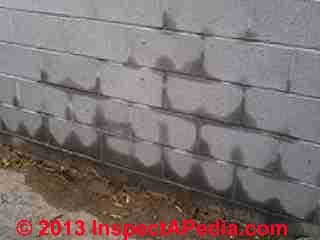 I have an unusual question. But please bear with me as I explain my story:
We had a brick wall put up a couple of months ago. My next door neighbor waters her plants almost every day and when she does she is constantly spraying my wall.
I have an unusual question. But please bear with me as I explain my story:
We had a brick wall put up a couple of months ago. My next door neighbor waters her plants almost every day and when she does she is constantly spraying my wall.
We’ve asked them several times if they could just move their sprinkler back a couple of feet so it won’t damage the mortar.
Their reply was “We can do what we want in our yard”. So now you know what kind of people we’re dealing with.
I’ve contacted our County Health Department to see if we could get them on a “wasting-water ordinance” but unfortunately according to [statutes in my state], they are NOT wasting water. So now I’m left with my neighbors damaging my wall.
I’ve attached a few photos to show what my side of the wall looks like. It’s horrific! Since my wall is so close up against their chain-linked fence, we can’t get to it to spray it with some kind of water sealant.
So my question is: Is there anything we could slip between my wall and their fence to take the brunt of the constant water exposure?
The only thing we come up with is some kind of sheet metal (but that would rust?) or some type of Plexiglass? or thin sheets of wood (would rot?)
This is my dilemma. Is there anything I’m not thinking of that would work? Any suggestions would be greatly appreciated.
P.S. I do not want to take my neighbor to court and sue for property damage if I can help it. That’s the very last resort. - Anon. 10/31/2013
Reply: try corrugated fiberglass roof panels of an appropriate color, placed vertically on the sprayed side of the block wall
Thank you for the interesting question - it may be unusual to you, but it's not rare for there to be a bit of a dust-up between neighbors over water and more over boundary issues. It's a shame.
A competent onsite inspection by an expert usually finds additional clues that would permit a more accurate, complete, and authoritative answer or suggestion than we can give by email alone. That said I offer these comments:
Your wall looks like concrete block, not brick. The significance is that concrete block is more porous and so admits more water passage through it more quickly than a brick wall would.
You are spot on target in wanting to either move the sprinklers back on the neighbor's side (you could offer to pay that cost) but I am doubtful that would be a complete cure as it'd be difficult to water plants right against the other side of your wall without wetting the wall somewhat.
You are also spot on target in thinking about putting a barrier on the outside of your wall. Since there is chain link fence in the way on the other side of your wall, coating it would be a mess, and may raise more neighbor issues as you'd have to be in their yard and trampling their plants to do so; and coatings constantly soaked by a sprinkler are not long-lived anyway.
I would choose a rigid plastic or fiberglass sheet material that can slip between the chain link fence and the block wall, on the outside of the wall, extending from ground to a height equal to the top of the chain link fence or top of your wall - whichever is lower.
In choosing a plastic or fiberglass material it needs to be self supporting unless the space between chain link fence and block wall is very small (say 1/2" or less); for self supporting material, take a look at white or green corrugated fiberglass roof panels. You can even give your nasty neighbor a vote on whether they would prefer to look at white or green.
Other plastics such as rigid plastic used by basement de-watering companies like B-Dri is not self-supporting and would have to be affixed to the wall - not feasible in the case you describe.
I share your disappointment in the neighbor, but frankly just fixing the problem on your own will be less upsetting and far less costly than litigation or a fist fight. Though a good smack might be tempting.
Water Forms Frost to Damage Retaining Walls in Freezing Climates
Watch out: water behind a retaining wall, if wet earth pressure isn't alone enough to damage the wall, is merely an annoyance or source of stains on a retaining wall in warm climates, but that same water can become a cause of serious frost or ice damage to a retaining wall in freezing climates.
Our illustration below, adapted from Farouki (1992) illustrates the heat flow down into the surrounding soil from an insulated building in a freezing climate. This illustration explains how to AVOID frost damage to foundations.
The illustrations above are discussed in more detail
...
Reader Comments, Questions & Answers About The Article Above
Below you will find questions and answers previously posted on this page at its page bottom reader comment box.
Reader Q&A - also see RECOMMENDED ARTICLES & FAQs
On 2020-01-14 - by (mod) - rely on indoor sump pump to prevent flooding?
Dana
While indoor sumps and sealing gaps and cracks are helpful "insurance" against actual flooding, it is never the best approach to let the water in and then try to get rid of it, nor to try to live life as the little Dutch boy stopping the collapse of a dam by holding his finger on the leak.
Let's instead go outside to see where water is coming from and how we can get it away from the home.
The no. 1 source is usually roof drainage spilling by the foundation
the no. 2 water source is usually in-slope grade towards the building
And of course on older buildings the footing drain system may no longer work.
See details at
BASEMENT WATER ENTRY PREVENTION
On 2020-01-14 by Dana - my basement flooding due to the sump pump not plugged in
Long story. I begin with my basement flooding due to the sump pump not plugged in to so much rain the pumps can't handle the water. I ha be 2 pumps. Got the indoor system put in. Though problem was fixed. Nope.
Must have been a drain hole in floor. .filled that. Last night we got a great amount of rain.
Woke up this morning with water coming in from door jam, outside retaining wall meets door.
So is the system not working or is the retaining wall and bottom of door just rotten from years of moister? I've had enough. Please help.
On 2019-10-16 by (mod) - water drainage around retaining wall between properties
Cynthia
See the page top EXPERTS DIRECTORY to find a home inspector in your area and chat with the inspectors you call about their familiarity with retaining wall issues;
You might also consult an experienced mason
Sorry but I cannot evaluate and prescribe a solution for the problem you describe from just the text - I just don't know enough about the situation - where water is coming from, what water redirection or avoidance steps are feasible, etc. .
On 2019-10-16 by cynthia - trouble with water drainage around retaining wall between properties
I have built a spec house where I am having problems with the water accumulated and damaging the neighbors cinder block wall. When my plans went thought the city my neighbor already had a cinder block retaining wall up.
I was told it was not enough and had to put in a more substantial one, so my builder had big cement blocks (prox. 18x36x24) craned in and put up against the cinder block. In some places there was an 1 1/2" gap between wall and blocks. Because I now looked into the neighbors backyard and had no privacy, I put a small wall 12" in front of it and planted a screen of hardy plants.
On the other side of this small planter wall is a 6 foot wide stripe of grass, then the patio.
Drainage was created under the grass, that takes the water to the ends of the yard. There is a drip line that runs the length of the hedge planted. My neighbor is getting water seepage, staining and now mold on her cinder block wall and is afraid if will effect the patio/driveway should the weather freeze.
I will admit that my landscaper was over zealous with the watering, but I have cut it back to 3X a week for 3min.
Obviously I cannot do any water sealing on my side with the thick cement retaining wall, but I need to know if I have any options that will protect and help her side short of turning off my water all together.
I would really like to solve this problem and have no idea how to. please help! (she sent pics, but i"m not sure how to get them from my phone to this site)
On 2018-10-21 by (mod) - white scale on surface of retaining wall: mold on wood, efflorescence on masonry
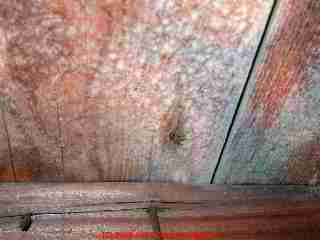 Dan
Dan
Your photo isn't so sharp that I can be certain that I'm seeing efflorescence instead of rot, but from your description my guess is:
mold - which is the most-likely contaminant to be found on a wood retaining wall.
You can see some photos of white mold on wood surfaces
The white mold on the wooden boards in my photo was found on roof sheathing (where there are multiple genera/species of molds growing, not all of which are white.
White stains also are sometimes found on wood as remnants of whitewash or as remnants of concrete or cement when the wood was previously used as part of a concrete form during earlier construction.
An example of white stains on wood that are not mold is at MOLD APPEARANCE - STUFF THAT IS NOT MOLD
But the most-common contaminant I'd expect on wood surfaces outdoors is mold.
Really? Well not necessarily: white deposits on a wood retaining wall could also be from mineral salts in some cases where rock, rock-dust or other masonry debris are immediately behind a wooden retaining wall.
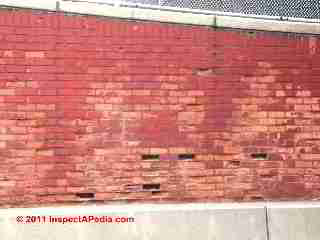 On masonry retaining walls deposits might be white effloresence, or on brick surfaces pink or red deposits.
On masonry retaining walls deposits might be white effloresence, or on brick surfaces pink or red deposits.
Most likely white deposits on a masonry or block or stone retaining wall are a mineral salt from mineral components in the stone and stone dust behind wall or in the soil behind it.
My photo of severe spalling along with extensive light colored reddish / pink efflorescence on this high brick retaining wall along the FDR Expressway in New York illustrates water damage that has led to deterioration of the wall without also causing buckling or cracking.
See details about this brick retaining wall
at BRICK WALL FROST & WATER CRACKS, EFFLORESCENCE, SPALLING
where we include other photos of white efflorescence salts on brick surfaces.
For the causes, effects, and cures of effloresence, see details
at EFFLORESCENCE SALTS & WHITE DEPOSITS
On 2018-10-20 by Dan L - white scale on a wood retaining wall?
Just had retaining wall installed a few months ago. Almost immediately notice white scale on surface. Wood is pressure treated. They did excavate and installed layer of rock behind wall to promote drainage and added a drain.
Is this related to pressure treating material leeching out and precipitating or is this sign of mold? It is dark under a deck. I did add solar ventilator under deck to increase ventilation and drying.
IMAGE LOST by older version of Clark Van Oyen’s useful Comments code - now fixed. Please re-post the image if you can. Sorry. Mod.
On 2018-07-27 by Anonymous
estimate to stop leaking of a retaining wall
On 2017-01-13 by (mod) - " bubbling" and "soft" surface on stucco retaining wall
Ellen
I'd start with some diagnosis: what's the cause, and some analysis: what's the effect. I suspect there are leaks into the wall cavity. No cosmetic repair will be successful unless the cause is found and fixed.
A home inspector (see the page top EXPERTS DIRECTORY) should be able to inspect for and help identify the problem cause, particularly if there are leaks; or a stucco contractor.
I can't prescribe the repair without knowing the cause. Typically: cut, patch, paint, fix leak.
On 2017-01-13 by Ellen
If there is " bubbling" and "soft" surface on stucco retaining wall what should be do? How to find cause on neighbors side and what is involved in repair if needed? What kind of specialist do I get to check it out?
Question: how to un-block clogged masonry wall weep holes
(Feb 17, 2014) Sal said:
I have round weep holes along my brick retaining wall that are not working. Is there anything I can use to unclog them?
Reply:
Sal, possibly - it depends on the problem. If the weep holes are clogged from insects, such as mud dauber wasps who love those openings, a careful routing with a suitably-sized tool and maybe using a shop vac to draw out as much debris as possible may be enough.
For a retaining wall (as opposed to a brick veneer or structural brick wall) it's also most likely fine to try jamming a rod back into the soil behind the wall, through the weep opening.
But if the weep holes never worked because they are blocked by dense mud, lacked gravel backfill, are clogged by concrete, or some other snafu, you'd need to take a different approach, possibly involving a long masonry bit. Perhaps if you use the CONTACT link to send me some photos I can comment further.
See details
at BRICK VENEER WEEPS BLOCKED or MISSING
Question: dirt coming out of retaining wall drain openings
(June 1, 2014) Kathryn Mundy said:
dirt is coming out of retaining wall weep holes in patio. I have tiny patio that abuts earth -- the top of the wall is at ground level of a row of neighbors that live up a hill behind me. I had this home 15 years. In last month I now have large piles of Dirt at openings of the 3 weep holes (I have photos) .
We recently had 3 days torrential rain; also possible there are mice (I live very near a river in a small town and river redraws rats and mice) also last year neighbor behind me built picket fence at top of wall (the earth behind wall is a dirt path with landscaping that leads out to parking area. What would suddenly be forcing so much dirt to come out of the weep holes at bottom of my retaining wall?
Reply:
Kathryn,
It's common for soil to wash through drain holes in a retaining wall, especially after heavy rains. If the wall has not moved, bulged, cracked, then it sounds as if the drainage openings are doing their job.
I'm not sure why there would be a sudden change, perhaps settlement or a surge in water behind the wall.
To avoid confusing other readers, a retaining wall is NOT part of a building structure, it is a wall built to hold back earth.
See RETAINING WALL DESIGNS, TYPES, DAMAGE
Question: how to un-block clogged brick masonry retaining wall weep holes
(Feb 17, 2014) Sal said:
I have round weep holes along my brick retaining wall that are not working. Is there anything I can use to unclog them?
Reply:
Sal, possibly - it depends on the problem. If the weep holes are clogged from insects, such as mud dauber wasps who love those openings, a careful routing with a suitably-sized tool and maybe using a shop vac to draw out as much debris as possible may be enough.
For a retaining wall (as opposed to a brick veneer or structural brick wall) it's also most likely fine to try jamming a rod back into the soil behind the wall, through the weep opening.
But if the weep holes never worked because they are blocked by dense mud, lacked gravel backfill, are clogged by concrete, or some other snafu, you'd need to take a different approach, possibly involving a long masonry bit. Perhaps if you use the CONTACT link to send me some photos I can comment further.
See BRICK VENEER WEEPS BLOCKED or MISSING
...
Continue reading at RETAINING WALL DAMAGE or select a topic from the closely-related articles below, or see the complete ARTICLE INDEX.
Or see these
Recommended Articles
- BLOCK FOUNDATION & WALL DEFECTS
- BULGE or LEAN MEASUREMENTS in retaining walls or in masonry foundations
- EFFLORESCENCE SALTS & WHITE DEPOSITS
- FOUNDATION CRACK DICTIONARY diagnose cracks & movement in masonry retaining walls
- FOUNDATION DAMAGE SEVERITY evaluate the seriousness of movement, cracks, leaning, bulges in masonry walls & foundations
- RETAINING WALL DESIGNS, TYPES, DAMAGE - home
Suggested citation for this web page
RETAINING WALL WATER DAMAGE at InspectApedia.com - online encyclopedia of building & environmental inspection, testing, diagnosis, repair, & problem prevention advice.
Or see this
INDEX to RELATED ARTICLES: ARTICLE INDEX to EXTERIORS of BUILDINGS
Or use the SEARCH BOX found below to Ask a Question or Search InspectApedia
Ask a Question or Search InspectApedia
Try the search box just below, or if you prefer, post a question or comment in the Comments box below and we will respond promptly.
Search the InspectApedia website
Note: appearance of your Comment below may be delayed: if your comment contains an image, photograph, web link, or text that looks to the software as if it might be a web link, your posting will appear after it has been approved by a moderator. Apologies for the delay.
Only one image can be added per comment but you can post as many comments, and therefore images, as you like.
You will not receive a notification when a response to your question has been posted.
Please bookmark this page to make it easy for you to check back for our response.
IF above you see "Comment Form is loading comments..." then COMMENT BOX - countable.ca / bawkbox.com IS NOT WORKING.
In any case you are welcome to send an email directly to us at InspectApedia.com at editor@inspectApedia.com
We'll reply to you directly. Please help us help you by noting, in your email, the URL of the InspectApedia page where you wanted to comment.
Citations & References
In addition to any citations in the article above, a full list is available on request.
- In addition to citations & references found in this article, see the research citations given at the end of the related articles found at our suggested
CONTINUE READING or RECOMMENDED ARTICLES.
- Carson, Dunlop & Associates Ltd., 120 Carlton Street Suite 407, Toronto ON M5A 4K2. Tel: (416) 964-9415 1-800-268-7070 Email: info@carsondunlop.com. Alan Carson is a past president of ASHI, the American Society of Home Inspectors.
Thanks to Alan Carson and Bob Dunlop, for permission for InspectAPedia to use text excerpts from The HOME REFERENCE BOOK - the Encyclopedia of Homes and to use illustrations from The ILLUSTRATED HOME .
Carson Dunlop Associates provides extensive home inspection education and report writing material. In gratitude we provide links to tsome Carson Dunlop Associates products and services.


